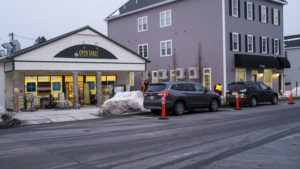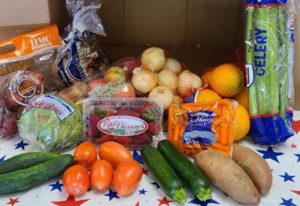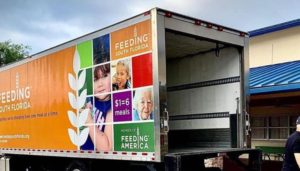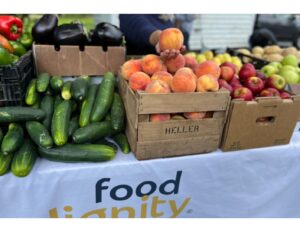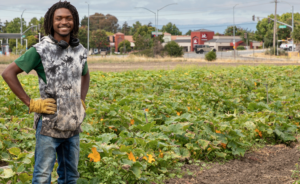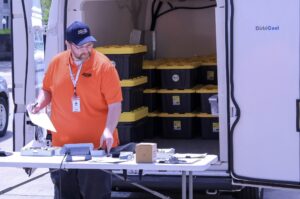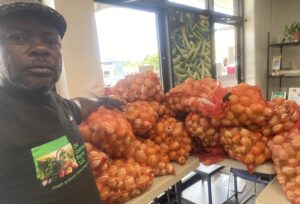The discord of farmers plowing under excess crops as food banks struggle to meet soaring demand is one image that Andrew Morehouse, Executive Director of the Food Bank of Western Massachusetts, does not have to worry about. Each year, about 40 small farms in the area donate half a million pounds of fresh vegetables to the food bank.
“The only reason we’re able to procure a half a million pounds of donated produce is because we honor a time-tested value of farmers, which is reciprocity,” he said. Specifically, the food bank spends about $150,000 per year to buy fresh produce from those same farms. And in early April, it reinforced its commitment to local farming with the acquisition of 142 acres of protected farmland where it will operate a second farm, in addition to a smaller one it has overseen since 1992.

While food banks routinely accept gleaned produce from nearby farms, fewer actively support local farmers via formal programs. Such programs have taken on new meaning over the past month, as news reports have lamented the disconnect between farmers with excess food and food banks with bare shelves.
The USDA stepped in on April 17 with its Coronavirus Food Assistance Program, designed to unite farmers and food banks on a national scale. But the program, which requires distributors to take food meant for large users like restaurants and repackage it into retail-sized boxes, is still in its early stages.
Meanwhile, food banks that have already been working to create resilient food systems at regional and local levels are way ahead of the game. “A lot of the work that we’ve done in the past was to prepare for what we’re doing right now. This is the emergency,” said Jeff Joslyn, Food Resources Manager at Feeding America Eastern Wisconsin.
In 2016, Feeding American Eastern Wisconsin launched Farm Link, an online marketplace that connects institutional buyers like area schools and hospitals to local growers. The food bank then leverages those relationships with farmers to create contracts in which the farmers grow crops on a certain number of acres and guarantee the food bank the entire harvest. “The idea was to remove some of the barriers to getting healthier local products into the hands of the people who need it the most,” Joslyn said.
Storing and transporting the fresh food is a major challenge. Joslyn said the food bank has two warehouses with limited cooler space. At the pantry level, cold storage is even harder to find, even after the food bank placed 50 commercial coolers at pantries across the state. “Mapping out who has the capacity to store and distribute that product is an ongoing thing,” he said. “It comes down to increasing the efficiency and decreasing the number of touch points to get it to the people who need it.”
In Alabama, Carey Martin-Lane and Natalie Bishnoi run the Farm Food Collaborative, which, like Farm Link, works as a connector between farmers and local buyers like school districts and affordable grocery stores. Though the food hub has been run out of the Food Bank of North Alabama since 2014, its primary mission is not to get produce into the food bank, but to address the root causes of local hunger.
The collaborative got its start when the food bank realized that two-thirds of the produce consumed in the U.S. was coming from outside the country, and that 54% of the farmers in its 11-county region were reporting losses. “We help make sales for farmers so that they can retain and create jobs in rural communities,” said Bishnoi, Co-Manager of the program. “We’re helping to increase access to these fresh, locally grown foods by getting them into different school districts and other facilities.”
The collaborative works with 15 to 20 farms per year, making connections and supporting distributions in whatever way it can, whether that means doing paperwork or delivering produce. “We wanted to keep our model as nimble and flexible and lean as possible,” said Martin-Lane, Co-Manager. “So every time we make a new transaction for a farmer, we determine at that moment what would be the most efficient use of resources.”
Working closely with growers does lead to donations for the Food Bank of North Alabama, as well. For example, when a local farmer recently lost a restaurant buyer due to Covid-19 closures, he sent three pallets of jumbo sweet potatoes to the food bank.
The importance of relationships can’t be overstated, said Morehouse of the Food Bank of Western Massachusetts. The food bank purchased its first farm in 1992, but the recent purchase of the second was only possible because of multi-year partnerships with Kestrel Land Trust, Massachusetts Department of Agricultural Resources, and the towns of Hadley and Amherst.
At its own farms, the food bank leases land to farmers in exchange for a percentage of their harvest. At the new farm, an even greater percentage of the produce grown will reach vulnerable populations. “By virtue of the funding we received, we have committed to an arrangement where the farmers will sell at least half of their share of the harvest to schools, so local farmers are supplying local schools with organic produce for at-risk youth,” Morehouse said.
The overall model has been so successful, he’s already looking toward purchasing a third farm. Establishing literal roots there is a first step toward growing an effective community presence that engages with the local food system. “The premise is to support local agriculture and to preserve local farmland,” he said. “This model is designed to be self-sustaining.”
— Lisa Elaine Held
Lisa Elaine Held is a freelance journalist based in Baltimore and Washington, D.C. She is currently a senior policy reporter for Civil Eats and covers the food system, sustainable agriculture, and food policy for many additional publications. Her stories have been published by Eater, The New York Times, Food & Wine, and NPR. She also produces and hosts the weekly podcast “The Farm Report” on Heritage Radio Network. Follow her work on Instagram or Twitter.
CAPTION ABOVE: A view of Food Bank of Western Massachusetts’ new farm.


